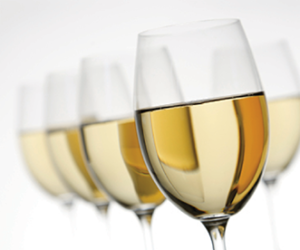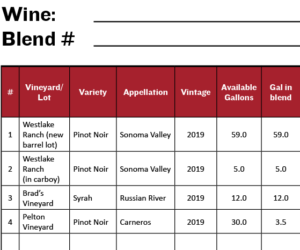
We are familiar with red wine blends, often simply called red table wines, but white wines? Who does this?
White wine blending is a more common practice in the commercial wine industry than recognized. The basic explanation to white wine blending is the essence of sparkling wine production, where the juice is blended from the different vineyards it’s harvested from. This method was introduced by the father of Champagne; Dom Perignon. Then there is the solera system used by the famed Sherry producers of Jerez, Spain. This is called a “fractional” blending technique, designed and practiced over hundreds of years to maintain a consistent style of the region’s Sherries.
Blending is prevalent in dry, still wine production too. The world wine market celebrates some of these classic white wine blends. European wineries blended white wines as a way to add character and complexity to a wine before knowledge of wine chemistry as we know it today came about. Some varieties offer up more acidity while others give more body or fruit characters. Wine laws were developed surrounding regional practices to protect the uniqueness of these white wine blends.
A classic example is the white Bordeaux of France. This white blend is dependent on the AOC of its region. Left bank, Graves, Entre-Deux-Mers, Côtes de Bordeaux, de Blaye, and de Bourg, all produce the white Bordeaux blend made from Sauvignon Blanc and Sémillon, but these blends can also include Sauvignon Gris or Muscadelle. An American white Bordeaux blend, also known as a white meritage, is made using the same two varieties of Sauvignon Blanc and Sémillon, but Muscadelle can also be added to the blend.
France is also known for its white wine blends of the Rhône region, where each variety offers its specialty to making a balanced white blend. The varieties involved here are Grenache Blanc, Clairette Blanc, Marsanne, Roussanne, Viognier, and Picpoul Blanc. The three most commonly used are Marsanne, Roussanne, and Viognier. This notable white Rhône blend is an excellent example of why one would blend white wines. Viognier provides a full body, viscosity, and aromatics. Marsanne lends minerality and floral notes of jasmine, honeysuckle, and acacia honey. Roussanne provides pears, nuttiness, aromatic herbal notes, and often adds more acidity to the Côtes du Rhône blend.
The Rioja region of Spain is famously known for Tempranillo, but there is a white Rioja blend that seldom escapes the country due to its popularity with the locals. Viura (Macabeo in Spain) is the predominant white grape, often blended with limited amounts of Malvasia de Riojo and Garnacha Blanca. If you get the chance to try one of these Rioja white blends you are in for a treat. This national white blend aims for easy drinking, neutrality that is smooth from aging in neutral American oak, and can be aged for decades.
Vinho Verde DOC of Portugal’s Douro region is a white wine blend made predominantly of Loureiro and Albariño (or Alvarinho) grapes. Portugal’s Dick Niepoort is known as the “trailblazer” of Douro’s white wine blending. He practiced combining terroirs into his popular table whites with the Loureiro providing the body felt on the palate, also stated as “richness,” while the Albariño is a great complement as a leaner grape with higher acidity. Sometimes Arinto, Trajadura, and other grapes may be added to this blend. These other mentioned white grapes are blended for a variety of reasons, all to the goal of flavor and complexity. The finished product of this region’s white blend is for minerality marriage to fresh citrus tartness while remaining low in alcohol and with higher acid.
The United States has its own wine laws that can disguise some of the white wine blends that happen in the commercial sector. According to U.S. laws, a single varietal wine must be a minimum of 75% of that variety, from the appellation of origin. Therefore, despite the varietal specified on the label, your favorite commercial white wine may actually be a blend of varieties given the large wiggle room in labeling. For a 100% varietal specified in a commercial wine, look for the statement on the label. Oregon has its own 90/10 law on specific state-grown varieties, which has made blending more strict and challenging there.
Besides the goal of complexity, the industry will find ways to utilize excess harvest yields in their wines. Like your mother throwing veggie scraps in the spaghetti sauce; it’s available, use it, don’t let it go to waste. Traditionally, home winemakers make the purest of variety wines, which is 100% varietal specific, and no varietal blending. But blending is an option to explore.
Why Blend?
At this point we see plenty of good examples of why blending white grapes has been used in global commercial winemaking. Contrary to common suspicion, blending whites is more than a means of ridding inferior wine. Blending provides an opportunity to produce a more balanced, complex wine or simply consistent product. In white winemaking, the focus is placed on acid and sugar levels. Different white grapes may be blended to assist with character building through reduction or elevation of acidity or sugar levels. It may also serve as a tool to balance or enhance flavor by decreasing foxy notes in V. labrusca grapes, or lowering strong flavors of V. rotundiflora grapes.
The practical approach to blending is if the same varietal is harvested from different vineyards, terroirs, or origins. Blending can happen during a co-fermentation, after separate fermentations, after aging, or just before bottling. Wine aged in different barrels of different woods, toast, or age of wood are practical reasons to blend to achieve a desired end product. Wines fermented by using different yeast strains can be blended to introduce more characters and complexities each yeast strain has to offer. There are many reasons to blend whites practically or out of necessity.
While researching for this article, a local commercial winery shared how their award-winning white wine blend came about. As can happen, fruit came in below the anticipated yield and so a white blend was made out of necessity. In 2022 there was a late, unexpected California freeze. These past home winemakers turned commercial producers, Brian and Jennifer Bumgarner, of Bumgarner Winery in Fairplay, California, lost most of their 2022 yield. To meet their needs for a white wine for their tasting room lineup, they simply made a “true field blend” using the surviving yields of three white varieties. At harvest, all of the white grapes that survived were harvested into the same bins and fermented together. The wine was called “Van Blanc,” after their son, Van, and a play on the French term for white wine, vin blanc.
The Van Blanc won many awards and the Bumgarners decided to continue to make this field blend. However, in 2023, a higher yield of Sémillon was harvested so a single varietal wine of Sémillon was produced and then the two other grape varietals were co-fermented due to lack of room in the cellar and blended with some of the excess Sémillon before bottling. Commercially or as amateurs, sometimes the decision to blend is made out of lack of room for each single varietal or on the contrary, to fill a void in the headspace of a barrel/vessel.
From a home winemaker’s perspective, blending is a good consideration if fermentation occurred in different locations, therefore different temperatures. As an example, let’s say one part in the basement and one part in the garage. Or one part in your friend’s house and one part in yours. Blending is a good consideration if wines were aged in different types of vessels, be it oak, glass, stainless steel, or plastic. Or even the same type at different sizes. The size is something to think about — blend a smaller volume with larger volume vessel, as the smaller the vessel, the wine is more likely to be “tight,” i.e., reductive. Blending is a good consideration when utilizing two different wine kits, grape juices, or musts to create something different and interesting.
Other blending considerations for home winemakers are when white native American grapes or French-American hybrids are involved. Again, growing conditions for these grapes sometimes lead to a shortage due to seasonal harvest challenges. There can be overwhelming characters that a little blending can help with, or acidity and/or residual sugar adjustments to contend with by blending.
Grapes to Consider Blending
On the East Coast, where more native and hybrid grapes are used, a blend of white grapes will help create a smoother finished product with less foxy notes or other matters. Gene Spaziani, author of The Home Winemaker’s Companion, shares experience and knowledge on the blending of many such grapes from the Eastern side of the U.S. French-American hybrids that he notes are popular blending whites including: Aurora, Cayuga, Vignoles, Seyval Blanc, and Vidal Blanc. Many wonderful Vignoles from New York State have been successfully blended with a little Chardonnay, thus increasing mouthfeel and softer notes without losing the unique character of Vignoles. Native American grapes that lend themselves to blending due to their foxy note include: Delaware, Dutchess, and Niagara. However, Delaware and Niagara can assist other grapes by improving sugar levels, and Dutchess can provide more fragrant aromas to any white blend.
Of the V. vinifera grapes, the two most commonly blended white grapes are Sauvignon Blanc and Chardonnay. Sauvignon Blanc has different clones, growing climates, terroirs, and different fruit characteristics that can be altered in making these aromatic but acidic blends. Chardonnay is the second most blended vinifera grape as it may be harvested from different vineyards or regions and be so different that it benefits from blending.
Chardonnay is most commonly blended after aging in various oak barrels; neutral to new oak, light to medium toast, all in an attempt to influence the wine’s character of butteriness. A personal favorite is a blend of 50% Chardonnay from oak and 50% from stainless steel, in which case the wine has a wonderful array of flavors and characteristics. Chardonnay is the go-to grape on the East Coast in blending with native and French-American hybrid grapes, all due to the reputation it has as being a “winemaker’s grape.” That is, it can be easily influenced by the winemaker’s choices in the winemaking and can be grown in cooler climates. Other white vinifera grapes often blended for the mere goal of character or complexity building include: Sémillon, Sylvaner, Riesling, Gewürztraminer, Grenache Blanc, Chenin Blanc, and Muscat.
When to Blend
When to blend white wines is dependent on the grapes you are working with and your goals in blending. Vinifera grapes may be blended at harvest, known as a “true” field blend. In doing this, it is important to have a consistent phenolic ripeness, acid level, pH, and Brix at harvest time. All of the grapes are harvested together, thrown in the same bins, crushed, destemmed, and pressed together. A word of caution is to understand that in a “true” field blend, the different grape varieties may ferment at different time frames. Brian Bumgarner waits two days, with his “true” field blend grapes in a cold soak first and then proceeds.
Whites can also be harvested, crushed, pressed, and fermented separately and then blended. Completing fermentation of the whites separately and blending them after is a safer approach as you know how each wine tastes independently and can do trials to determine the best blend. Another cautionary note shared by Brian Bumgarner is to be sure the yeast strain has finished its job in each wine before blending.
Another optional time to blend is after aging and pre-bottling, which is the approach the majority of West Coast wineries use when blending. If doing this, be sure to test the SO2 levels of each varietal, adjust SO2, and then blend, respecting that SO2 levels can be at different levels in different whites. Completing this step a good month before bottling allows any nuances to jell together.
Using a recipe is a recommendation for the first-time endeavor at blending whites if you aren’t ready to conduct bench trails. Using wine kits can provide recipes to follow and more helpful instructions on making the separate whites, then one can blend two kits following a recipe. Some wine books like Spaziani’s or The WineMaker Guide to Home Winemaking provide recipes, as well as education on bench trials that I would recommend familiarizing yourself with if you are not already. Recipes are helpful as most varieties at different acid levels can temper each other out during the blending process. Therefore, the earlier blending is done, the more time there is for acid adjustments, if need be.
Bench trials provide the most fun approach to blending with which anyone can learn more about wine sensory from their own experiments. Bench trials occur after fermentation has completed but before final acid adjustments are made. Work with the basic fractions of 75/25 up to 100%. That is 75% one varietal and 25% another varietal as one sample, then 80/20, 85/15, 90/10, and/or anywhere in between. If three different whites are blended, begin with 30/30/40 and so forth. It all depends on your vision and goals. These are just illustrations that whites can be blended in various ways, not necessarily as any one “traditional” way.
How to Blend
How to physically blend whites is pretty straightforward. But for those who have never done so before, a word of caution: Be sure to blend carboys with the full one securely sitting on a table above the empty carboy, using a siphon tube, allowing gravity to assist with transferring wine from one carboy to the next. Use a clean and sanitized vessel to blend into. Already have your math done to know just how much of one to blend to the other(s). If you are fortunate to have a pump, this can ease the process, as you pump and blend the whites into one singular vessel. Keep the siphon nozzle below the surface of the wine to avoid bubbling, which introduces more oxygen to the wine and can create oxidation.
The WineMaker Guide to Home Winemaking has the most conclusive section on wine blending of all the assorted books I pulled resources from for this article. It stresses selecting the wines you wish to use to blend. Determine your goal for the blending. Assess the wines for their strengths and weaknesses. Focus on elevating the wine you have the most volume of, and how it is you want to complement it with character, balance, and mouthfeel. How to improve its taste or complexity. The guide also includes recipes to utilize for home crushed grapes, juice, and kits.
Lastly, invite trusted friends to assist you in deciding which is the direction you wish to go. Make a “blending party” out of it. Then enter the wines into competitions to see how calibrated palates might assess the finished wine and provide feedback on your new award-winning creation that you will now share with those trusted friends.







